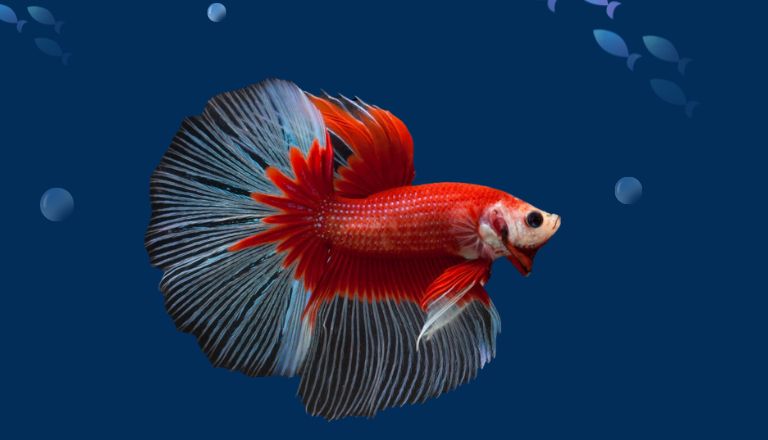The Complete Butterfly Betta Fish Care Guide
The Butterfly Betta is a beautiful fish with bright colors and pretty fins. It is popular among fish enthusiasts for its looks and interesting behavior. It is a great addition to any aquarium.
In this comprehensive guide, we will cover every aspect of Butterfly Betta Fish care, from setting up the perfect tank environment to understanding their specific dietary needs and providing proper maintenance for their well-being.
Whether you’re experienced or new to fishkeeping, this guide will give you the information and tips you need to help your Butterfly Betta stay healthy in its tank. Come with us to learn how to create a happy home for your Butterfly Betta.
Butterfly Betta Fish Facts & Overview
Butterfly Betta fish are a beautiful type of Betta fish. They have colorful patterns that look like butterfly wings. These fish come in many colors and patterns, which makes them popular among fish enthusiasts. Butterfly Bettas have long, flowing fins that add to their elegance and beauty.
The Butterfly Betta, known as the Siamese Fighting Fish, originates from Southeast Asia, primarily Thailand, Cambodia, Laos, and Vietnam. These countries are home to diverse and vibrant ecosystems where the Butterfly Betta thrives in shallow waters.
Butterfly Bettas are known for their territorial nature. Male Bettas in the wild claim territories and protect them from other males.

Butterfly Betta fish make fantastic additions to freshwater aquariums due to their eye-catching colors and unique fin patterns. These fish do well in a clean aquarium and provide endless fascination for their keepers by taking good care of them and watching their social behaviors.
Typical Behavior
Butterfly Betta fish are known for their mesmerizing beauty and unique behavior. In a tank environment, these stunning fish exhibit fascinating behaviors that captivate any observer. One typical behavior of the Butterfly Betta is their territorial nature. They establish their own space within the tank and defend it from other fish.
Butterfly Bettas are known for their vibrant displays of courtship behavior. During mating rituals, males will flare their fins and display intricate dance-like movements to attract females’ attention. This colorful and graceful courtship ritual is a sight in any aquarium setting.
Butterfly Bettas are curious; they constantly explore their surroundings and investigate plants, rocks, and tank decorations with keen interest.
Appearance
The Butterfly Betta fish is stunning in an aquarium. Its colorful pattern looks like butterfly wings. The fish has bright blue, red, and white colors.
In a well-maintained tank environment, the Butterfly Betta’s appearance is enhanced through proper lighting and plant selection. The shimmering scales of the fish catch the light creating an effect that adds depth and dimension to its stunning colors. Live plants make Betta fish look more beautiful as they swim.

Butterfly Betta in your tank provides aesthetic pleasure and offers a unique opportunity to observe nature’s most beautiful creations. Its appearance makes it a prized addition to any aquarist’s collection.
Habitat and Tank Conditions
Create the right habitat and tank conditions for your Butterfly Betta to keep them happy and healthy. When creating a habitat for the Butterfly Betta, recreate an environment that mirrors their natural surroundings in the wild. These vibrant fish are found in slow-moving waters with dense vegetation, so providing them with a well-planted tank, makes them feel right at home. Create hiding spots with plants and driftwood to reduce stress and promote their natural behaviors.
In terms of tank conditions for Butterfly Bettas, maintain a consistent water temperature for their health and well-being, along with regular water changes to keep ammonia levels in check.
To help the fish thrive, make sure to have good filtration and enough space for swimming.
Tank Conditions
Maintain ideal tank conditions for the happiness and well-being of your Butterfly Betta. These vibrant fish thrive in warm water temperatures between 75-80 degrees Fahrenheit and prefer a pH level of around 7.0.
To keep the tank clean and free from ammonia buildup use a filter and change the water regularly.
Create an environment with live plants, smooth rocks, and hiding spots to enhance your Butterfly Betta’s mental stimulation and happiness. Avoid overcrowding the tank with too many decorations or tank mates, because bettas are territorial by nature and prefer their own space.
Monitor the water parameters such as ammonia, nitrite, and nitrate levels for a thriving ecosystem for your Butterfly Betta.
By focusing on these tank conditions, you can create a stimulating environment that helps your fish stay healthy and happy.
What Size Aquarium Do They Need?
For Butterfly Betta fish, provide an aquarium size of at least 2.5 gallons for a single fish. For optimal health and happiness, a larger tank of 5 gallons or more is suitable. The extra space allows the Betta to swim more freely and exhibit its natural behaviors without feeling cramped.
A larger aquarium means better water quality as there is more room for filtration systems and maintenance equipment.
It will be tempting to start with a smaller tank, but a larger aquarium will benefit both you and your Butterfly Betta in the long run.
Tank Mates
When choosing tank mates for your Butterfly Betta, consider their peaceful nature and delicate fins. Opt for fish that are non-aggressive and won’t nip at the betta’s trailing fins for a harmonious community tank.
Good companions for Butterfly Bettas include small schooling fish such as Neon tetras, harlequin rasboras, and dwarf Corydoras catfish. These species coexist peacefully with bettas due to their similar temperaments and size.
Choose fish that get along with your Butterfly Betta to create a lively tank that highlights their beauty and keeps all the fish safe and happy.
Tank Mates (To Avoid)
When choosing tank mates for your Butterfly Betta, avoid aggressive or fin-nipping fish that may stress or harm your delicate Betta. Species like Tiger barbs, large Cichlids, and Gouramis are notorious for their territorial behavior and may harass or attack your Butterfly Betta. Their vibrant colors and flowing fins attract unwanted attention from these aggressive tank mates.
Fast-swimming species like danios or active fish such as mollies are not the best companions for the peaceful Butterfly Betta. Their constant movement stresses out Betta, who prefers a calmer environment.
Diet
These beautiful fish require a varied diet for optimal health and vibrant colors. Feed Betta fish a high-quality pellet or flake food made for them. Feed them frozen and live foods such as bloodworms, brine shrimp, or daphnia to provide additional nutrients and keep them engaged during feeding times.
Overfeeding leads to obesity and other health issues and underfeeding results in malnutrition. Feed small portions multiple times a day to mimic their natural feeding habits in the wild. To help your Butterfly Betta stay healthy in its tank, feed it a balanced diet that meets its nutritional needs.
Butterfly Betta Care
To keep Butterfly Betta fish happy and healthy in a tank, you need to consider their specific needs. These fish are colorful and unique and require special care. Provide them with a clean and adequately sized tank of at least 5 gallons in capacity. Maintain the water temperature between 75-80 degrees Fahrenheit for Butterfly Bettas because they are sensitive to temperature fluctuations.
To keep your Butterfly Betta happy, make sure the water is clean and at the right levels. Add plants and decorations for them to swim around and hide in. This will make them less stressed and keep them entertained. Feed your fish good Betta pellets or flakes and sometimes give them treats like bloodworms or brine shrimp for their health.
Regular water changes, filtration maintenance, and monitoring of water quality parameters are important aspects of caring for these beautiful creatures.
To help your Butterfly Betta fish stay healthy and happy, give it a good diet, keep its tank clean and spacious, and provide hiding spots. These things will help your fish thrive in its home.
Breeding the Butterfly Betta
Breeding the mesmerizing Butterfly Betta is a rewarding process that requires patience and dedication.
Start by choosing healthy male and female Betta fish that are mature and ready to breed. Set up a separate breeding tank with plenty of hiding spots for the female Betta for the safety of the male during courtship.
When the male starts to build a bubble nest at the water’s surface, introduce the female into the tank carefully, and monitor their interactions closely. The male will display vibrant colors and flare his fins to attract the female towards the nest where she will release her eggs for fertilization.

After spawning occurs, remove the female Betta from the tank to prevent any aggression from the male towards her or potential harm to the offspring.
By taking good care of the water, temperature, and food for the parents and baby fish, you watch the Butterfly Bettas grow into beautiful adult fish for your aquarium.
Conclusion
This guide gives helpful tips on how to take care of Butterfly Bettas. From setting up the ideal tank environment to understanding their unique dietary needs, every aspect of caring for these beautiful fish has been covered in detail.
By following the advice outlined in this guide, Betta enthusiasts ensure the health and well-being of their beloved pets. Monitor water parameters regularly, provide a varied diet, and create a stimulating environment for your Butterfly Betta to thrive.
With dedication and proper care, you enjoy a long and rewarding relationship with your aquatic companion.
Start implementing these tips today to create a happy and healthy home for your Butterfly Betta Fish!
FAQs
Are Butterfly Bettas Aggressive?
Butterfly bettas are not inherently more aggressive than other types of bettas. They do have a natural territorial instinct and can display aggression towards other fish, especially males of the same species. Provide them with enough space and hiding spots in the aquarium to reduce potential conflicts.
How Long do Butterfly Betta Fish Live?
Butterfly betta fish typically have a lifespan of around 2-3 years. With proper care and a healthy environment, they can sometimes live up to 5 years or even longer. Factors that can impact the lifespan of butterfly bettas include water quality, diet, genetics, and overall health.
What is a Butterfly Betta?
A butterfly betta is a type of betta fish that is characterized by its unique coloration pattern. This pattern typically consists of a solid base color that gradually transitions into a different color at the edges of the fins, resembling the wings of a butterfly. The colors are usually vibrant and can range from blues and reds to purples and yellows, creating a striking and visually appealing appearance.







